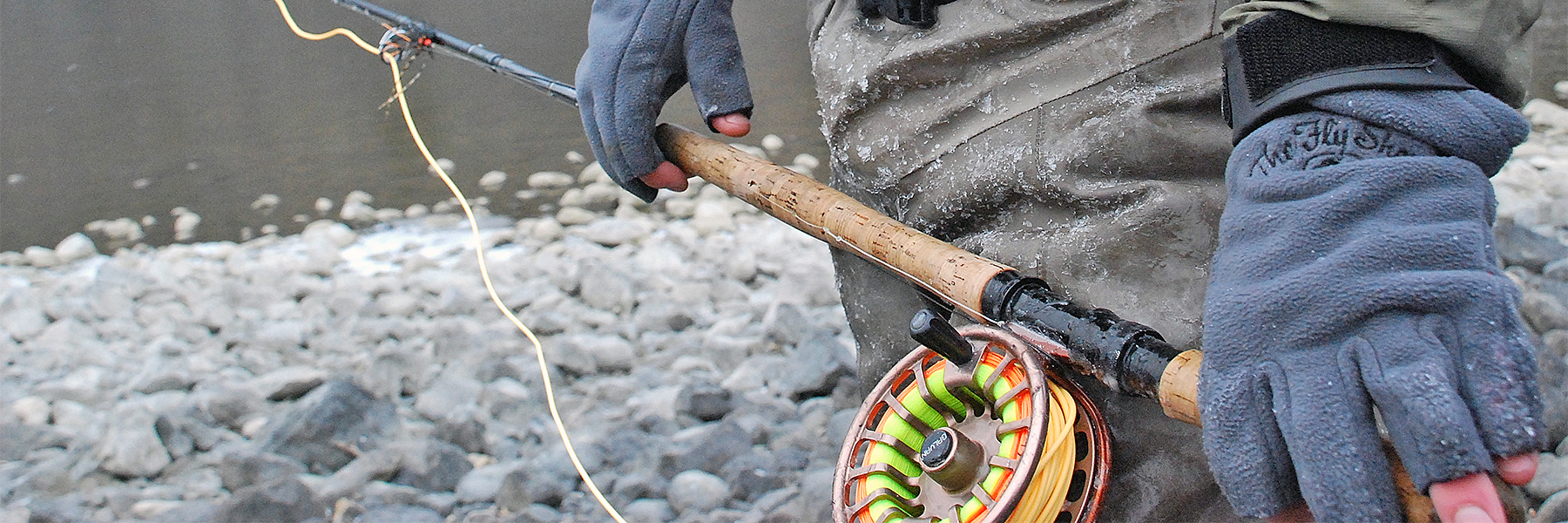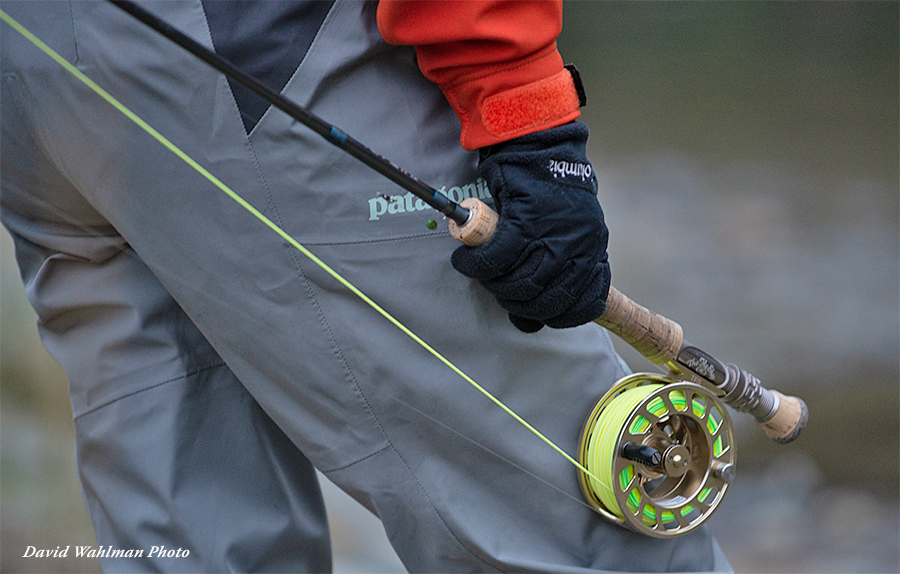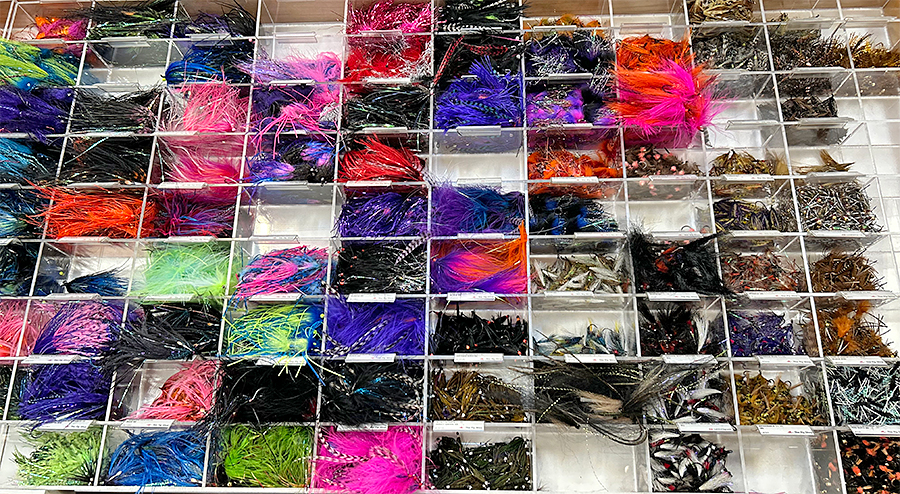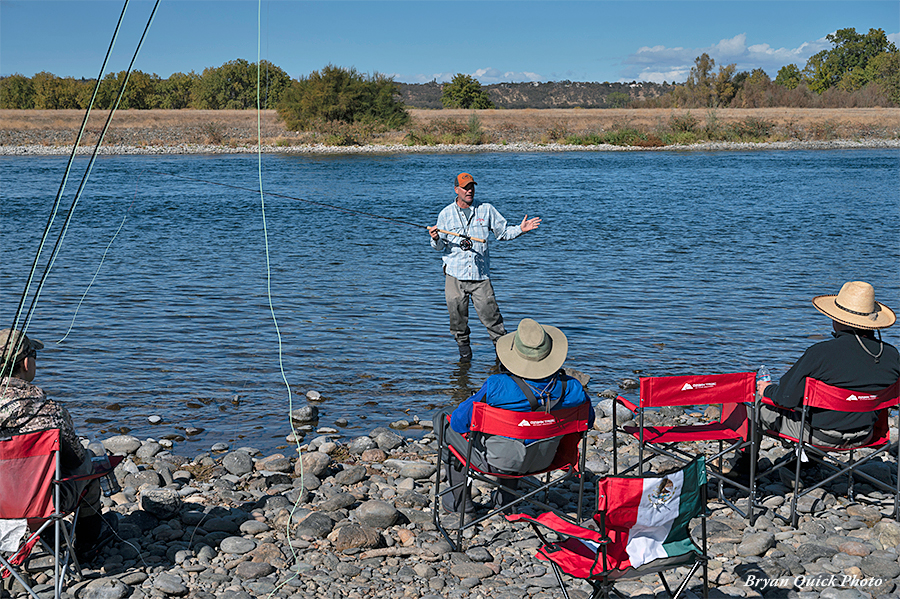In our last post we covered the “Clothing for Fall Fly Fishing”. As we said we would, here is the follow-up to that article with the gear needed to switch seasons.
As summer gives way to autumn, some, not all, anglers look to put away our 8’ 4-weights and size 18 PMD’s and break out the big sticks. We dust off our puffy jackets and pull out the fly boxes that don’t require reading glasses to tie on the offerings inside.
The question for this article is, where should we start? A lot goes into selecting the right gear for steelhead, aka chromers. Let’s start with rods. Then we will take a look at reels, lines and flies as well.
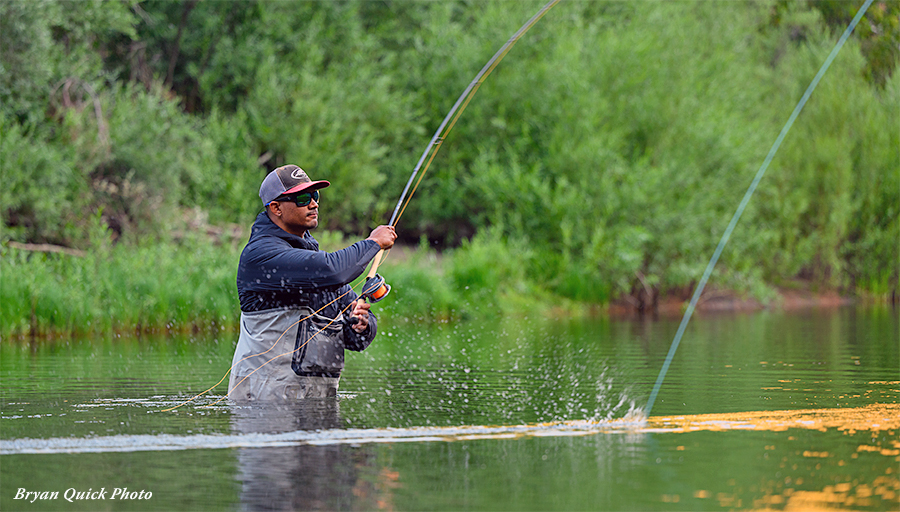
Two-Handed Rods:
Two-handers, or Spey rods, have taken over the swing game in the steelhead world because with a Spey rod you can cast further, more often, and with less effort. It is a far more efficient method, and extremely fun, beautiful, and less taxing on your arms, backs, and shoulders throughout the day. An accurate analogy would be comparing a screwdriver to a cordless drill. The Spey rod market has changed significantly since the double-handed salmon rods showed up on the scene in the late ’90s. The days of the 14-foot 9-weight are over. For inland rivers, like the small water of the Trinity or Klamath, think 11-foot 5-weight or 12-foot 6-weight. You will need a larger rod to handle the big winter fish on the coast or up in B.C. The best all-around line weight would be a 7-weight. Some recommended rods:
- Scott Swing – 12’8” 6wt
- Scott Swing – 12’8” 7wt
- Sage X – 13’0” 7wt
- Echo TR2 – 13’0” 7wt
- The Fly Shop’s Spey Rod – 12’6” 6wt
- Winston Air TH – 12’ 5wt
New to Spey Casting or want to tune up your skills? Check out our 1-day clinics in November. We will get you fine tuned casting a two-hander regardless of the weather conditions you will face chasing chromers!
Single Hand Rods:
There are several ways to fish for steelhead, and using a single hand rod is still very popular with many anglers and guides. Here on the Trinity River, there are options for both swinging and indicator fishing for steelies.
A technique that has been perfected by The Fly Shop® guides is dead-drifting nymphs under an indicator. For the Klamath or Trinity Rivers, you will want a 9’0” to 9’6” 6 or 7-weight rod. Pair that with an anadromous or nymphing taper line, and you will be very happy. You can go up a size to an 8-weight if you want, but in our experience, it is not necessary for the inland rivers of California. For the big coastal fish, however, an 8-weight can help you regain the upper hand after the initial mayhem when you have hooked one of these monsters. The Scott Centric 6-weight with the fighting butt is a nice, lightweight rod with plenty of backbone that will allow you to get your rig into the run and keep it fishing all day without tiring. Likewise, the Winston Air Freshwater rod is great to fish your nymphs. For some extra length, Sage’s R8 Core series and Igniter series (6-weight only) rods have 9’6” options in 6 and 7-weights, and these will allow you to mend your line from just a little further away.
- Scott Centric or Sector – 6wt
- Winston Air 2 Freshwater – 6wt
- Winston Air Saltwater – 7 or 8wt
- Sage R8 or Igniter – 6-8wt
- The Fly Shop’s Signature Indicator Rod – 6wt
For single-hand swingers, all of the mentioned rods will be great. The best rod out there is the new Scott Swing 9’8” 7-weight or 9’8” 8-weight. If you are fishing a sink tip or full-sink line, you need to be able to make that initial roll cast to set up your pickup. Both of these have plenty of backbone and will set you up for a laser presentation into the juice. The extra length and moderate action for these new beauties will help with mending and line control.
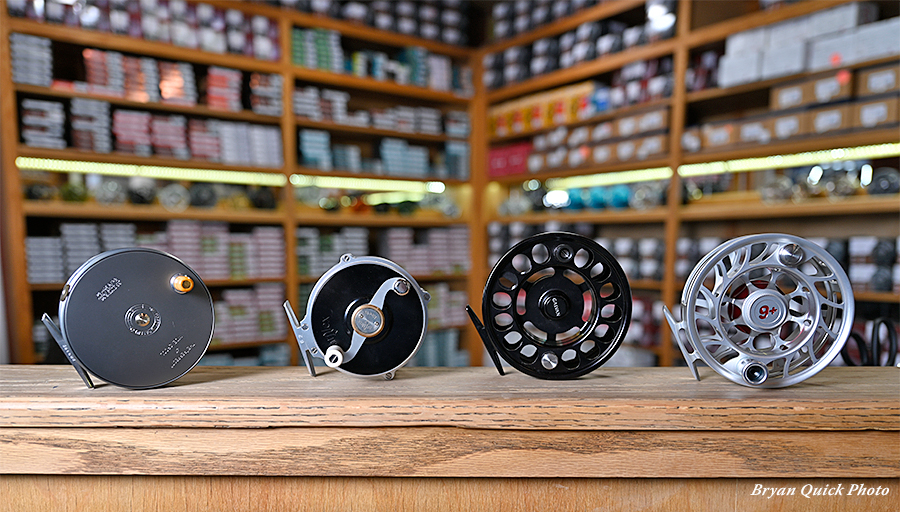
Fly Reels:
This is where the arguments generally start and continue … Do you go with a traditional click and pawl, such as the Farlex or Hardy Perfect? Or do you go with something a bit newer with a full drag? There have been far more anadromous fish caught using a click and pawl reel than have been with a drag. From swinging flies for Atlantic salmon in the 1800’s ‘til the development of the stopping power of cork, Rulon, and graphite drag systems, a good drag is a real help when trying to land these powerful fish. But for aesthetics, nostalgia, and sound quality, many die-hard steelheaders prefer the older technology of a click and pawl.
2-Handed:
-
- Farlex Spey
- Hardy Perfect
- Galvan Rush LT
- Hatch Iconic 9+ or 11+
Single Handed:
-
- Abel Rove, Vaya, Sealed Drag Salt (SDS)
- Ross Animas or Evolution LTX
- Galvan Rush LT, Torque, or Grip
- Hatch Iconic
- Lamson Guru S
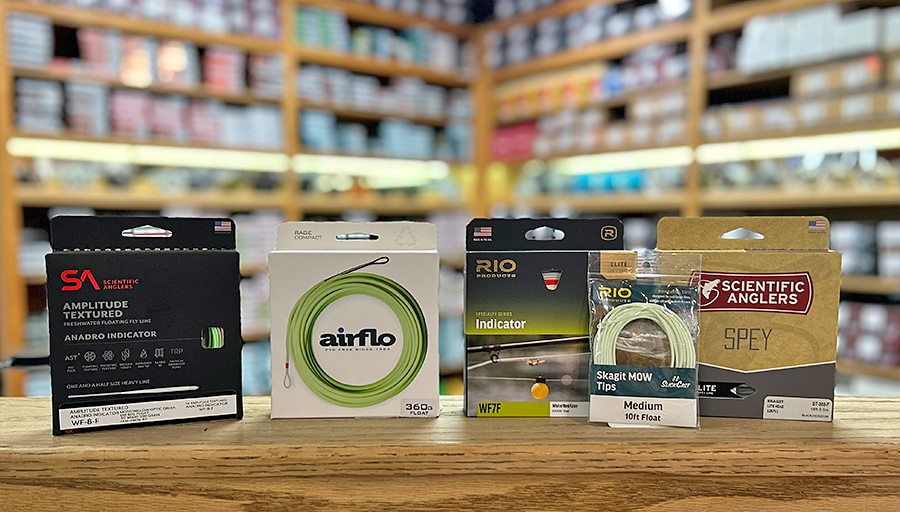
Fly Lines:
Again, this one becomes a bit tricky depending on how you are going to be fishing for steelhead. It could also depend on where you are fishing. In the two-handed world, you will need two line systems – one for presenting a fly at or near the surface and one for getting deep. You will also need an array of sinking tips and leaders. For single-hand operations, a line with a longer head is preferred for mending during the drift or swing. Very few anglers swing flies on a single-hand rod these days. Those who do use an integrated shooting head with a sinking tip.
2-Handed: (From surface to deepest)
-
- Scientific Anglers Spey Lite
- Airflo Rage
- Airflo Skagit Driver
- Airflo F.I.S.T.
*Required Interchangeable Sink Tips for Skagit Heads
MOW T-14 Tips: 2.5’, 5’, 7.5’, 10’, 12.5’
A selection of 10 ft custom cut tips in different sink rates
Single Handed:
-
- Scientific Anglers Amplitude Anadro
- Rio Elite Indicator
- Airflo Streamer Max Short (sink tip)
- Airflo Scout head with interchangeable tips

Leaders & Tippet:
Leaders and tippet are the last link in the chain between you and the fish of your dreams. Getting it right is critical for casting and presentation, while also being strong enough to handle a chrome missile. This is one item you will not want to skimp; it is arguably the weakest link in your connection to a fish. And given the time, effort, and expense you will expend chasing these fish, the few dollars you saved on tippet will provide no comfort as you reminisce about the fish that broke off.
Swinging:
For summer steelhead fishing with Scandi lines, you will need a long-tapered leader off the end of your shooting head. The leader must be at least the length of your rod to properly anchor your D-loop to the river’s surface during the cast. Fine tune the length by adding 10lb. Maxima tippet.
-
- Rio Tapered Steelhead Leaders – 12ft. 10 – 16lb.
- AirFlo Polyleaders 10ft.
- Maxima Ultragreen 10lb.
For winter fish, we just use Maxima level tippet to make a cheap “leader” off the front of your sink tip. No tapered leaders are needed. Just loop to loop 4 – 5 feet of 15lb. Maxima onto your sink tip, tie a fly on the other end and let ‘er rip!
-
- Maxima Ultragreen 15lb.
Single Handed:
If you are dead drifting nymphs, the easiest option is to use a 9ft. tapered leader in 0 -2 X. You use an indicator on this, or you can tight-line nymph. Or you can build yours right from the butt section to the first fly on your own. How, you might ask? Well, there are as many ways to skin this cat as there are guides and anglers. This would be a great topic for another blog post on its own. For swinging flies with a single-hand rod, the tapered leaders work very well. A 9ft. 2X leader will get the job done nicely.
Flies:
With the ability to fish with a single-hand or two-handed rod, the flies you use will depend on the style you are using.
Swinging:
Early season fish are super grabby and not too particular about what you put in front of them. Probably the most important thing is to get your fly in front of a steelhead. That said, the tried and true flies on the Trinity and Klamath Rivers are:
Later, when the water cools down and the fish are less likely to move to a fly, you will need something that will present a larger profile. Intruders in black and blue work great, but don’t pass up on pink and purple.
If you are looking for a challenge, try skating a fly on the surface. Early season fish are just as likely to chase down your fly on top as they are to eat a subsurface fly.
Under an Indicator:
When it comes to fishing for steelhead under an indicator it’s all about eggs. We’ll save the bead debate for another post. But, these little round balls of pink and orange produce takes. Around our home waters, stoneflies play a huge role in taking steelhead as well as small attractor nymphs like the Psycho Prince and Copper Johns in various colors.
There are a lot of different methods to consider when chasing steelhead with a fly rod. Maybe you’ve been thinking about giving two-handed fishing a try but just aren’t sure how to get started. We got you covered. We will be holding our 1-Day Spey Casting Clinics this November (3rd & 4th) on the Lower Sacramento River just south of town. Chris King, Master Certified Two Hand caster with the International Fly Fishing Federation, teaches these 1-day schools. After either or both of these days with Chris you’ll be able to get out there and sling 2-handers with the best of them.
If you need to brush the rust of your double handed rod casting, these 1-day Spey clinics or a day on the water with one of our Swing Guides will get you back in the groove.


